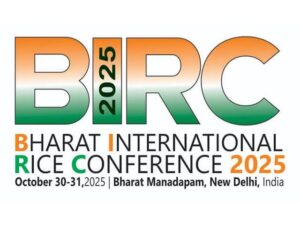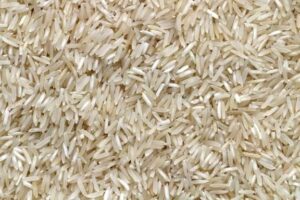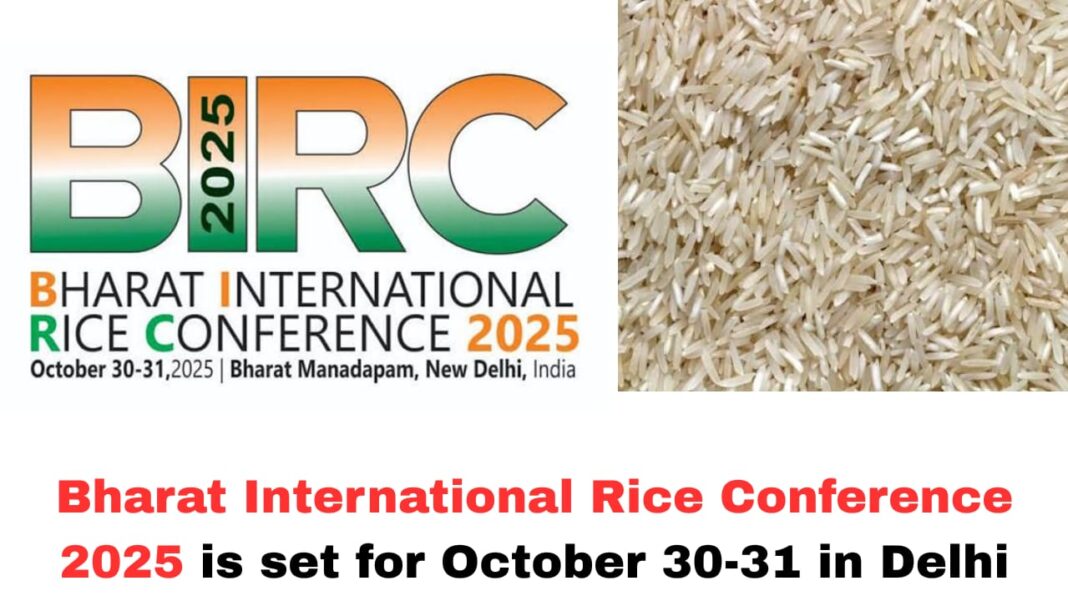Digital News Guru New Delhi Desk:
Bharat International Rice Conference 2025
India is gearing up for a pivotal moment in its agricultural-export journey with the upcoming Bharat International Rice Conference (BIRC 2025), scheduled for October 30–31 at Bharat Mandapam in New Delhi.
A Strategic Platform
Organised by the Indian Rice Exporters’ Federation (IREF) in partnership with the Agricultural and Processed Food Products Export Development Authority (APEDA) under the aegis of the Ministry of Commerce & Industry, BIRC 2025 is designed to bring together the full ecosystem behind rice in India — from farmers and processors to exporters, importers, policymakers, logistics experts and technology providers.

The event is not just a conference: it’s an exhibition, a marketplace, a technology showcase and a policy forum rolled into one. From high-tech sorting lines and quality control to value-added rice products and export financing, the ambition is clear—to broaden India’s rice export footprint.
Export Ambitions: New Markets & Big Targets
India already stands as a major rice exporter. According to IREF leadership, the country aims to increase its share in the global rice trade from current levels (around 40 % of global production;) to a target of 55–60 % of global exports.
One of the key announcements ahead of BIRC is that India has identified 26 new target countries — including Indonesia, Saudi Arabia, Japan, Mexico and Vietnam — where India’s rice exports could grow significantly. These markets currently import about 1.8 lakh crore worth of rice from competitors.
Domestically, this represents a major push: IREF has indicated plans to sign export MoUs and contracts worth about 25,000 crore during the event, with long-term value from new markets of the scale above.
Innovation, Quality & Value-Addition
BIRC 2025 puts a strong emphasis on technology and quality. For example, one of the headline features is the launch of India’s first AI-based rice sorting system — capable of detecting grain colour, shape, size and broken-grain segregation in one pass.
In addition to processing technologies, exhibitors will showcase premium varieties (both basmati and non-basmati), organic rice, region-specific Geographical Indication (GI) rice, seed and agronomy packages, storage & logistics solutions, and FPO/co-operative clusters from across states such as Assam, Odisha, Telangana, Haryana and Jammu & Kashmir.
Implications for India & Global Markets
For India, the conference is a statement of intent: agriculture is no longer just about domestic food security, but about global competitiveness, value-added exports and farmer incomes. By strengthening processing, logistics and export linkages, India seeks to move up the value chain rather than just exporting bulk, unprocessed rice.

For global markets, India’s push has several implications:
- Increase in supply of rice globally may reduce prices and ease food-security pressures in rice-importing countries.
- Competitive pressure on other major exporters (Thailand, Vietnam, Pakistan) could intensify, especially in the next round of contracts.
- Importers may gain from more diversified sources, improved quality and new product varieties (e.g., organic, GI-tagged premium rice).
Key Challenges to Watch
While the ambitions are large, there are key hurdles:
- Quality standards and traceability: New markets often require stringent certifications (residue limits, traceability, processing standards). India will need to ensure consistency across the chain.
- Logistics and infrastructure: Exporting rice at scale—not just quantity but quality—requires modern warehousing, sorting, packaging, shipping and cold-chain where needed.
- Domestic balance: While pushing exports, India must ensure domestic food security and moderate prices for consumers and farmers alike.
- Global trade environment: Trade policies, tariffs, competition and currency fluctuations can impact export competitiveness.
- Follow-through: Announcements at the conference are only the first step—turning MoUs into actual shipments, ensuring new buyer-relationships are sustained, and monitoring outcomes will be crucial.
Why Now?
Several factors have converged to make this moment opportune:
- Strong production base: India produced around 150 million tonnes of rice in 2024-25 from about 47 million hectares, accounting for roughly 28 % of global output.
- Improved yields, better seed varieties, expanded irrigation, better agronomic practices — all contributing to supply readiness in India.
- A global environment where food security, supply-chain risk mitigation and diversification of sourcing are high on importing countries’ agendas.
- Technological readiness: The push towards AI-based sorting, value-addition and branding means India is aiming for more than just volume.

The Road Ahead
As BIRC 2025 unfolds in Delhi, the real story will be in what comes after. Will the conference deliver:
- Firm contracts and market entries into those 26 identified countries?
- Measurable increase in export volumes beyond current levels?
- Higher revenues for farmers and processors, improved value-addition rather than commodity exports?
- Infrastructure upgrades — processing, logistics, packaging — that offset bottlenecks?
- A sustainable model that balances export focus with domestic needs?
If India succeeds, we could see a reshaping of global rice trade patterns — with India not just the largest exporter in volume, but the most sophisticated, diversified and competitive supplier. Conversely, if follow-through falters, the conference may turn out to be a milestone in ambition rather than in impact.
Conclusion
BIRC 2025 is more than just a trade show; it is a strategic declaration that India intends to lead the world not only in producing rice—but in exporting it at scale, at quality, and in value-added form. For the country’s rice sector — farmers, millers, exporters, researchers — the spotlight is on Delhi. What happens in these two days could well determine how India’s rice story evolves for years to come.
You May Also Read: “Baahubali: The Epic” Returns to Theaters on October 31, 2025








